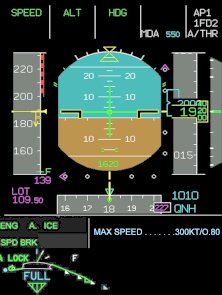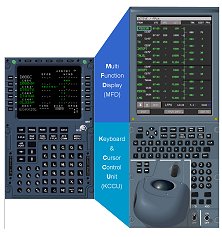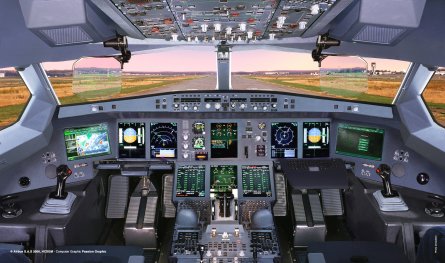Flightdeck to rival Boeing 787’s by using A380 technology and keeping commonality with earlier Airbus types
It is remarkable to think that the simple, uncluttered flightdeck design in which all pilots of Airbus fly-by-wire (FBW) airliners spend their working day has been with us for almost 20 years. It is also remarkable that, given the impressive way in which Airbus has updated the original concept with new levels of interactivity and expanded information displays for the A380, the manufacturer was until recently planning to equip its new long-haul twinjet, the A350, with a cockpit that had more in common with the original A320 design.
“We had a big meeting on 13 January and decided to adopt the A380 flightdeck for the A350,” says Capt Jean-Michel Roy, Airbus vice-president training and flight operations. “The key driver for this decision was the unanimity of the [Airbus] test pilot community as well as the demand from the airlines for more technology and the family concept with the new A380,” he adds. “We recognised the importance of interactivity and decided to go towards an A350 interactive cockpit concept flightdeck, which is similar to the A380’s.”
|
|
| The A350's flightdeck (top) is effectively a replica of the A380's, having previously been A330-based (bottom) |
Until this landmark decision at the start of the year, the A350 flightdeck was effectively the A330/A340 design (itself little different from the A320’s, which entered service in 1988), incorporating where possible some improvements developed for the ultra-large A380, but not its larger, Thales-developed, expanded display suite for flight information, navigation, monitoring and flight management system (FMS) functions.
Part of the problem facing the A350 engineers was that the A380 flightdeck – with its deeper displays and on-board information terminal (OIT) screens flanking the main panel on either side – does not physically fit in the Airbus widebody cockpit section. This has been resolved as a byproduct of the need to revise the A350’s entire nose to accommodate the underfloor flightcrew rest compartment.
As part of the nose redesign, the cockpit tweaks have been incorporated and include a simpler flightdeck window arrangement and space for what is effectively a facsimile of the A380 flightdeck. The only major differences are those associated with the two- rather than four-engined configuration, although the tailplane trim wheel may also be retained on the A350 if Airbus decides to stay with manual trim rather than adopt the electrical trim design of the A380.
The A350 has been on a somewhat hesitant development path since Airbus first began serious studies in mid-2004 into a response to the then Boeing 7E7. The A330 was taken as a base and, in a series of steps since the official unveiling in December 2004, the A350 has evolved into what is effectively an all-new aircraft – with the exception until now of the flightdeck.
Boeing’s plans for the 787 cockpit did not officially break cover until September last year. Despite retaining what Airbus pilots may regard as the antiquated concept of a control yoke, the 787’s configuration is a significant step forward from the 777’s and in some respects more advanced than the A380’s. The 787’s cockpit is dominated by the five Rockwell Collins-supplied 12 x 9in (305 x 230mm) liquid crystal displays (LCD) making it the cleanest looking design yet to have emerged from Seattle – but it retains enough commonality with the 777 to allow pilots to be converted with five days of differences training.
So the pressure was mounting on Airbus to rethink its plans for the A350 flightdeck and, after the internal decision was taken in January, the change of plan was formally revealed at Asian Aerospace in Singapore in February. Less evident from the Singapore announcement was the fact that the late switch has resulted in a programme slip of around three months, but Airbus is hopeful that it will mitigate the impact during the aircraft’s development cycle.
In place of the six 6 x 6in displays that made their debut on the A320 18 years ago (and have been a feature of every FBW Airbus up to the A380) and two small multipurpose control display unit (MCDU) screens, are eight identical 6 x 8in LCDs. Despite the switch, Roy says the A350 will have the same type rating as the A330, requiring four days differences training. It will be capable of cross-crew qualification with the four-engined A380, with seven days differences training.
 |  |
| Aircraft configuration is displayed on the PFD (left); the navigation display incorporates vertical flightpath data (right); the traditional MCDU is replaced by an expanded FMS display, QWERTY keyboard and tracball (below) | |
 |
As on the A380, the larger displays enable additional information to be provided on the two screens in front of the pilot. Roy says that the primary flight display (PFD) now has “more information, at the right place, and at the right time. For example, a clear representation of the aircraft configuration is provided next to the airspeed scale because it is logical to see what your minimum and maximum speed is according to your flaps, slats and gear configuration.”
On the expanded navigation display (ND), there is the ability to get “a better understanding of the third dimension” with a vertical -situation display, says Roy. “Not only does it show what we are going to do in altitude versus distance with the different waypoints, but also with obstacle data coming from the EGPWS [enhanced ground proximity warning system] and also more information coming from the flight management system, improving situational awareness and enhancing safety,” he says.
Central to the new level of interactivity offered on the new flightdeck is the revised MCDU, through which the crew control the FMS. Roy says the traditional MCDU is “split in two”, with one part being a larger multifunction display (MFD) and the other – dubbed the “keyboard and cursor control unit [KCCU]” – incorporating a trackball and QWERTY keyboard rather than the A, B, C, D type layout on traditional MCDUs that Boeing has retained for the 787’s FMS control.
“The trackball is the key element to control the interactivity,” says Roy. As well as selecting items on the FMS’s menu, the trackball enables the pilot to move the cursor between the MFD and ND when, for example, seeking information on a diversion airport, or specifying a target runway exit on the on-board airport navigation system (which displays an airport map on the ND) for the automatic “brake to vacate” feature being introduced on the A380.
The A380’s electronic centralised aircraft monitoring functionality has been expanded to incorporate the normal and abnormal checklists, which are controlled through a new switch panel mounted on the centre pedestal aft of the thrust levers. “We are able to ‘tick’ items that are not automatically sensed by the aircraft – for example that the cabin crew has been advised by the pilots about landing,” says Roy.
The A380’s improved, integrated communication system is incorporated, which provides a single interface for combined audio control and radio management. “The radio management panel is much simpler than the system fitted on today’s A330,” says Roy.
In its first iteration, the A350 had the pull-out, tabletop-mounted on-board information terminal design developed for the existing FBW families, but the adoption of the A380 configuration sees the displays adjacent to the PFD screens. These displays are not touchscreen-enabled, with inputs made using keyboards mounted on the pull-out tables.
The A350, like the other members of the Airbus family, will be offered with single or dual head-up displays supplied by Thales.
It may have taken its time deciding on the A350’s flightdeck philosophy, but Airbus is confident the rethink brings many benefits. “We pushed our design office strongly to have the A380’s technology, as we could not achieve the interactivity properly without adopting the new cockpit,” says Roy.
He adds: “The commonality with the A330 will make a lot of sense for today’s operators moving to the A350, while A380 operators can have mixed-fleet flying with the A350.”
MAX KINGSLEY-JONES / TOULOUSE
Source: Flight International

























